Whether you’re wondering “How do I to start a raised garden bed?”, “What is the best soil mixes for vegetable gardens?” or “How do I improve my raised bed?” we think that the following information will be helpful to all groups of gardeners.
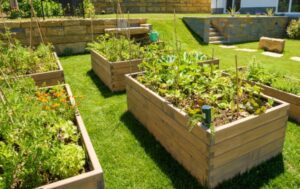
One of the most popular garden beds in and around the Chicago suburbs is the Raised Bed. We can say this with a good deal of confidence since at least half of our soil mix sales are for above-the-ground planting beds. A raised garden bed is simply a container or box full of soil in which plants are grown. Raised beds (also called planter boxes) are most commonly constructed of wood, but they can also be made of other materials such as stone, bricks, concrete, galvanized metal, or logs.
Where in-the-ground gardens have no sides and are set directly into the dirt, Raised Bed gardens sit on the ground and have sides of various heights.
Here are a few reasons why Raised Beds are so popular:
- Raised beds will stay warmer than soil in the ground. This helps to extend your growing season because you’re able to plant earlier in the spring and continue later into the fall.
- When you use the proper soil blend, raised beds drain better. We incorporate coarse sand into our Raised Bed mixes to insure proper drainage and to keep the soil loose, easy to weed and stress-free to work in.
- A properly prepared raised bed allows plant roots to breathe – again when you use the right soil mix you ensure good root development and root breathability. This means healthy, productive plants with much less time and effort.
- An above ground garden with its elevated height is more ergonomically comfortable, making it easier to tend to plants without the need for excessive bending or kneeling. This can be a big plus for anyone – but especially for people with physical limitations or back problems.
- The soil inside the confines of the raised bed provides for better weed control and reduces the likelihood of
![raised bed soil mix]() soil erosion. In-ground gardens with their direct contact of plants with the ground makes them more susceptible to weed growth, pest infestation and soil-borne diseases. Additionally, In-ground beds also require regular soil maintenance, such as tilling and amending, to ensure optimal growing conditions.
soil erosion. In-ground gardens with their direct contact of plants with the ground makes them more susceptible to weed growth, pest infestation and soil-borne diseases. Additionally, In-ground beds also require regular soil maintenance, such as tilling and amending, to ensure optimal growing conditions.
When you fill your raised garden beds with fresh weed-free soil, they’re far less likely to grow weeds inside them at all. In contrast, native soil and in-ground beds may contain weeds and weed seeds.
Also, the tall sides of a raised garden bed prevent weeds from creeping in from the yard or the garden pathways around them. You can also prevent invasive weeds from sneaking in from below by laying some type of quality weed barrier under the raised bed before filling it with soil. Examples of weed-smothering materials include weed barrier fabrics or unwaxed cardboard. If you chose to use a fabric liner to help prevent weeds, be sure to use a commercial grade weed barrier fabric with a long life expectancy. (ie. 15-20 years) Avoid lining the bottom with plastic sheeting as this will not allow excess water to drain which could lead to root rot.
- Raised beds built out of materials such as wood or stone are generally more resistant to degradation compared to soil directly in the ground. To make raised beds even more permanent, use materials that are specifically designed for outdoor use and treated to withstand both weathering and pests. Yes, it’s safe to use treated wood to construct your raised bed. For those with concerns, line the walls with polyethylene (aka. plastic), just don’t extend the plastic so it covers the bottom and stops proper drainage.
- With raised garden beds, you have control over the condition, quality, components and texture of your soil. Rather than simply working with what you’ve got in the ground, raised beds can be filled with an ideal soil – like our Raised Bed Mix, that your plants will love and is specifically blended for growing plants in an above ground environment. Remember: soil quality and composition is THE most important factor that leads to a healthy and successful garden. Using the best blend will get you the best result.
- Raised beds are usually deep, with ample space for roots to grow. Larger, deeper root systems means
![Raised wooden garden bed]() bigger and more healthy and productive plants. But you might be thinking: Doesn’t an in-ground garden bed inherently have “deep” soil too? Yes, but you must consider the composition of the native soil. In and around the southwest suburbs of Chicago here the native soil in largely clay, large rocks, or other less-than-ideal soil structures. As such, you’re either going to need to work really hard to till and amend the soil deeply, or remove a large portion of the native soil and then re-introduce a sandy loam soil mix. (A great sandy loam soil is rich in organic matter, has a texture that is loose enough to easily allow root growth, will readily absorb water, and is also well-draining. We build these positive characteristics into all of our Raised Bed garden blends.)
bigger and more healthy and productive plants. But you might be thinking: Doesn’t an in-ground garden bed inherently have “deep” soil too? Yes, but you must consider the composition of the native soil. In and around the southwest suburbs of Chicago here the native soil in largely clay, large rocks, or other less-than-ideal soil structures. As such, you’re either going to need to work really hard to till and amend the soil deeply, or remove a large portion of the native soil and then re-introduce a sandy loam soil mix. (A great sandy loam soil is rich in organic matter, has a texture that is loose enough to easily allow root growth, will readily absorb water, and is also well-draining. We build these positive characteristics into all of our Raised Bed garden blends.) - Growing plants in raised garden beds provides an extra layer of defense against pests. The frame and height of the raised bed serves as an obstacle and potential deterrent for pests like slugs, snails, and (most) rabbits. For additional security from pests it is easy to add side fencing, hoops and floating plastic row covers tucked neatly over the beds to block them altogether. This is also effective against rodents, squirrels, birds, skunks, neighborhood cats, and more.
- With raised beds, destructive burrowing pests like gophers, moles, and voles can be blocked off from below, preventing access to the bed and plants completely. If these little guys are a concern for you, lining the bottom of your raised bed with galvanized hardware cloth (mesh) right at ground level can protect your plants from below. (We don’t recommend using chicken wire for this as it will disintegrate over time and has larger holes making it easier for pests to chew threw.)
- Raised beds add visual interest to a garden space. They create dimension and a well-defined growing area. Planter boxes of different sizes, heights and shapes can be placed to create unique and attractive garden designs. Not to mention that wood planter boxes can be quite beautiful in their own right – even when they’re empty. And, it’s easier to keep raised garden beds looking tidy than in-ground garden beds. The distinct edges and borders prevent pathway ground cover like gravel or bark mulch from spilling into the planting area itself.
- Since you are not walking in the bed, the soil doesn’t get compacted and stays loose without the need for backbreaking digging every spring. Raised beds help to keep things organized and in check.
- Raised beds give you control over the soil you put in them, making it possible to plant more plants, since plants grown close together in raised beds tend to mature faster. (Always follow the recommended plant spacing provided with your seed pack or started pot.
- You can strategically locate your raised bed to maximize accessibility to:
Direct sunlight
Your hose or appropriate water source
Pathways for easy movement of wagons and / or wheelbarrows
The size you choose: Your bed can be 4ft. x 4ft. or 4ft. x 20ft long or anything in between
- A few final benefits of raised garden beds is that you can install them almost anywhere; you can plant vegetables, annual or perennials; and, like pots and other containers, raised garden beds are versatile – and can even be movable. Where with an in-ground garden you’re limited to where you happen to have open available soil.
There are a lot of options when it comes to the material used to construct a raised bed. Wood Raised Bed Kits come with the components required to build the bed. (One drawback to these kits is their small size.) Galvanized metal tubs, troughs and containers have grown in popularity largely because of their ease of setup.
Common materials used to build a raised bed from scratch include:
- Wood is a popular choice that’s easy to construct and use. Cedar and redwood are good options because
![plant garden soil mix]() they’re naturally resistant to insects and decay. The drawback with these wood options is that they can be expensive.
they’re naturally resistant to insects and decay. The drawback with these wood options is that they can be expensive. - Modern pressure treated lumber has chemicals to prevent rot. Unlike the past versions of these products, studies show that with today’s pressure treated lumber, any compounds that leach out of the wood are well within safe levels established by the EPA. The safety of pressure treated wood depends on the specific treatment used. Older methods involved chemicals like arsenic, which posed more significant concerns. Modern treatments, such as ACQ or CA-B, use safer preservatives. Choosing wood treated with these newer methods reduces potential risks. Gardeners who still have concerns using with treated wood can line the sides of the bed with polyethylene plastic. Remember, if you go with treated lumber, you must use ground-contact lumber in order for your bed to last.
- Railroad ties (treated) are easy to use because you can simply lay them on the ground and drive in iron spikes. They can be used single high or stacked on top of each other for additional depth. Old railroad ties treated with creosote do not appear to pose any health problems because most of the creosote has leached away. Again, for those with a concern about chemical leaching, line the sides of your bed with polyurethane.
- Pallets can be an economical option for garden bed materials, provided you know where they came from. Pallets are developed for shipping materials. Avoid pallets that are also treated with a chemical called methyl bromide, a known endocrine disruptive chemical which can impact your reproductive health. Most pallet producers stopped using the chemical in 2005, but many old pallets are still out there. Look for a stamp on the pallet that says “HT” or heat treated. If there is no stamp or you can’t verify an HT on the surface, don’t use the pallet in your garden. One drawback of pallet wood is that it’s not very long-lasting.
- Composite lumber is a great option for melding the aesthetic of wood with modern and more durable technology. One drawback of composite is it’s relatively higher cost. Composite lumber is not really wood but rather a blend of wood fiber and recycled polypropylene. Composite wood is a good option for a long-lasting raised bed in a wet or humid environment.
- Concrete blocks or bricks: These are both durable and stable. There is the outside possibility that any concrete product will raise the soil pH (alkaline). This is not a big worry, but if you are going several blocks high with something like cinder block, you might want to consider adding some peat to the bed to naturally correct any increase in alkalinity.
- Galvanized Metal: Galvanized steel is rust-resistant and weatherproof, provides for drainage but may raise soil temperature. Troughs have a drainage hole so when used as a watering device, the tank can be drained. You should add more drainage by drilling additional holes. Another tip is to place the trough on a base of blocks. This not only helps keep the drainage holes open, but can provide a nice cool spot for frogs and toads. They’ll eat the insects in your garden.
- Garden grow bags and boxes: Garden grow bags are large, flexible, fabric-like bags or boxes that can be
![Raised beds can be made from many different materials]()
Raised beds can be made from many different materials used to grow plants and vegetables. They are usually made of plastic, but can also be made from breathable fabrics like burlap or polypropylene. Grow bags are often lightweight and have handles attached to make them easier to lift.
If you’re wondering how deep your Raised Bed should be, there are no hard and fast rules, but you may want to consider what you’d like to grow in the bed. (See the lists below) Width, on the other hand, should not be so wide that you can’t reach the center of the bed from the edge. Usually 4 feet is considered the appropriate maximum width.
Raised beds with a depth of 6” are well suited for:
> Lettuce, salad greens, spinach, onions, leeks, radishes, strawberries, basil, chives, cilantro, dill, mint, oregano, parsley, thyme, marigolds, and annual flowers
Raised beds with a depth of 12” are well suited for:
> Beans, beets, broccoli, Brussels sprouts, cabbage, cantaloupe, carrots, cauliflower, collards, cucumbers, garlic, kale, summer squash, Swiss chard, turnips, lavender, rosemary, sage, borage, calendula, cosmos, lantana, nasturtiums, snapdragons, sweet alyssum (plus everything in the 6” list)
Raised beds with a depth of 18” are well suited for:
> Eggplant, okra, peppers, pumpkins sweet potatoes, tomatoes, watermelon, and winter squash (plus everything in the 6” and 12” groups)
Things to Avoid When Starting a Raised Garden Bed
Raised beds are often preferable over traditional in-ground gardens because they offer better drainage, provide for easier access to plants and offer more control over the quality of soil. Here are 8 things you should avoid when starting your raised bed garden.
-
Setting the Bed in the Wrong Spot
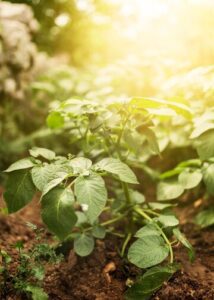
It’s important that you orient the position of your raised garden bed correctly, as it proves very difficult to move your entire garden bed later on. Here are some factors you should consider:
- Sunlight:Choosing a spot that does not receive direct sunlight for at least six hours can have adverse effects on the plants. Ample sun is necessary for most plants to flourish, especially vegetables. Therefore, you should choose a sunny spot in your garden to situate your garden beds. You should not orient it East-West, but rather North-South to ensure the right amount of sunlight. Plant smaller crops in the front (from South to North) and the tallest crops in the back. Keep in mind that some plants such as peas prefer shade. Also, if you’re installing your bed in early spring or late fall, consider the shade coverage of nearby trees that will leaf out during the growing season.
- Level ground:Avoid low-lying areas that are prone to collecting or pooling water. Excess water in a raised bed leads to root rot and will hasten the degradation of your wood bed. Make sure the raised garden bed sits on level ground. If it’s not, it will leak both moisture and soil from the corner(s) that are not in contact with the ground. Don’t place the raised bed against the fence or wall, as it prevents access from all four sides. Any don’t put your raised bed on a wood deck.
- A complement to the rest of the garden:You want to locate your raised bed in a place that blends in and even complements the rest of your garden. Raised garden beds can be aesthetically pleasing if made with the right materials and placed “square” with the world.
-
Not Lining the Bottom of your Bed
You can place your raised bed directly onto the ground. There is no need to remove the underlying grass and native soil – in fact, in doing so you may actually be inviting more weeds. This is commonly referred to as the “No-Dig Method”. (Adding your fill material and/or soil over the ground with no lining is an open invitation to weed growth and development.)
Although you don’t dig into the ground under your bed, you will still need to separate the grass / native soil from the bed soil. Mow your grass as short as possible; then, lay your layer of cardboard – over-lapping it by 6 inches or so; then water it until completely soaked. We highly recommend putting down the cardboard and then a layer of quality, durable landscape fabric. A quality landscape fabric will block weeds from growing through but still allow water to drain. Where the cardboard layer will help smother and kill the existing vegetation, the landscape fabric should help prevent any sneaky weeds from growing up and through over time. If you’re planning on adding that layer of galvanized wire mesh for pest control, do it over your fabric.
Many gardeners chose to add some “fill” material to the bottom of their bed before they actually put in the garden soil. This step is optional but does have benefits if you use organic materials. Avoid using rocks for fill as eventually the soil will mix with the rocks and will prove to be very difficult to remove later on. The gravel also raises the water level, which can lead to problems with fungal diseases and root rot.
Great fill options are organic materials like compost, straw, grass clippings, wood chips, leaves, and woody material like logs, dry wood, and branches. As they break down, they enrich the soil and create an environment for beneficial fungi and microbes. (More on garden soil later.)
-
Not Considering Your Water Source

When you choose the area to locate your raised garden bed, consider the water source, as both overwatering and under-watering can have detrimental effects on your plants. Simply put – The place you chose to locate your bed should have nearby water access. To avoid constant watering, you can also think about a drip irrigation system. Many people will just go with a lawn sprinkler system, which is inefficient. This wastes a lot of water and often causes problems related to fungal diseases. If you are planning on building only a few raised garden beds, a soaker hose is fine and may be a good alternative if an irrigation system is too expensive. What many gardeners find useful, is adding indicator plants such as lettuce to the veggie garden, as these will quickly wilt if they don’t receive enough water.
-
Setting Your Beds to Close Together
Since going with raised garden beds makes gardening easier and more enjoyable, many people look to “go big or go home” and install more than 1 raised bed. Nothing wrong with that – but placing them too close together can make it difficult to weed, plant, move wheelbarrows or garden wagon between beds or to harvest plants from the within the beds. So, be sure to create a comfortable working area by allowing enough room between the raised beds. Having a walkway of at least three to four feet between each bed offers you ample access, and allows you to move a wheelbarrow or cart around with ease.
-
Crowding the Bed
While it’s possible to grow almost anything in a raised bed garden, serious consideration needs to be made toward plant mature size. Nearly every seed packet or potted starter plant includes information of plant mature size – including height and spread. Please follow these guidelines as a minimum. Remember, deeper beds are capable of growing large plants in addition to smaller one.
-
Planting the Wrong Plants
Start out with easy to grow vegetables if you are a beginner. These include things like tomatoes, zucchini, and bell peppers. Herbs such as basil, thyme, and mint are also easy to tend and grow. Some plants, like asparagus, are perennials, so you should not plant them unless you want to harvest them every year.
Be sure to choose vegetables that will do well within both your climate and season. Here where we are – just southwest of Chicago, we’re in Growing Zone 5. Neighborhood retail outlets and garden centers like ours will likely stock only plants appropriate for sale within their zone. The same cannot be always said of mail-order suppliers. Crops can also be grouped into cool-season crops and warm-season crops. Lettuce is a cool-season crop and is best grown in the Spring and Fall. Beans, tomatoes, cucumbers, pumpkins and corn are considered warm season crops.
 Obviously, plan to grow vegetables that you enjoy eating and will use often in your cooking. That way, you will make the best use of your garden’s harvest. You can transfer plants that have defects or any surplus to the compost pile, which can later be recycled back into the soil.
Obviously, plan to grow vegetables that you enjoy eating and will use often in your cooking. That way, you will make the best use of your garden’s harvest. You can transfer plants that have defects or any surplus to the compost pile, which can later be recycled back into the soil.
You should introduce variety and avoid mono-cropping (planting only one kind of plant) which can deplete the soil of vital nutrients. A useful concept to learn is companion planting, a method that places plants with complementary characteristics in close proximity to each other, such as nutrient requirement or pest-repellent abilities, to maximize crop productivity. Click this link for access to the Old Farmer’s Almanac of Companion Plants for the garden. Don’t be afraid to even add flowers as they are not only beautiful but can help to deter pests.
-
Skip adding mulch
This is a common mistake that gardeners make with raised garden beds. Too many people do not add a mulch layer as they think it’s unnecessary and adds costs to the production. But, mulch is very helpful for a number of reasons. While the garden is raised off of the ground, weeds can and will grow to invade your bed. Adding a layer with mulch can help keep the weeds at bay as well as retain moisture around the roots of the plants. Mulch also helps regulate the temperature of plants better than plain soil.
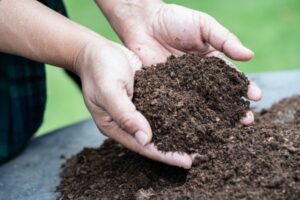 Organic mulch can be used to improve soil quality and richness. It is important to keep the area weed free and avoid using herbicides in your raised bed. These toxic chemicals can linger for many years, and can migrate to other areas of your garden as run-off. That’s why organic mulch options are so much better.
Organic mulch can be used to improve soil quality and richness. It is important to keep the area weed free and avoid using herbicides in your raised bed. These toxic chemicals can linger for many years, and can migrate to other areas of your garden as run-off. That’s why organic mulch options are so much better.
Wood chip mulches, for instance, are quite popular but they are better suited for ornamental beds. Generally, when it comes to wood chips and vegetable and herb gardens, you want to avoid directly mulching or mixing chips into the soil or garden bed you are planting into. As the wood pieces break down, they can temporarily bind up nitrogen in the soil, something that heavy-feeding vegetables need to grow properly.
Plastic mulches, weed barrier cloth or landscape fabric, are also effective, but they tend to break down when exposed to the elements and create a mess in vegetable beds.
Instead, the best mulches for vegetable gardens tend to be natural mulches that will add nutrients to the soil as they break down. Additionally, because vegetable gardens are often mulched every year, mulches that are easy to come by and inexpensive to use are usually the best options. They include:
Compost is one of the best soil amendments that you can use in gardens. It boosts soil nutrient levels and improves the drainage of garden beds. But compost is also a great mulch as it brings a lot of benefits to the garden. When used as mulch, compost will contribute nutrients to the soil and it will boost the activity of beneficial microorganisms and earthworms. Not to mention, finished compost has a nice, dark color and a uniform particle size that can make vegetable beds look even more appealing. And of course, you can make your own compost. As with any mulch used in your garden, a 2” layer of mulch is fine.
- Organic compost is made from composted plant material like leaves, grass clippings, small twigs and vegetable scraps. Organic compost is often referred to by gardeners as “Black Gold”.
- Mushroom compost is actually the media mushrooms are grown in: composted straw, composted horse manure and peat. Because it contains straw, it’s likely to include some weed seeds. Composted horse manure is aged and turned regularly so it’s much more like dirt than manure. Still, this type of compost makes for a better soil amendment than mulch.
![purple cow organics]()
- Purple Cow Classic Compost is our favorite compost (or mulch) as it is weed-seed and pathogen free; a 100% plant-based and organic product, and OMRI Listed for organic production.
- Shredded leaves contain a lot of nutrients that will enrich your soil and enhance earthworm activity. Plus, because many gardeners mulch their planting beds in autumn, fall leaves are particularly convenient because you can gather them just in time for mulching.
Please keep in mind that unshredded leaves will quickly mat down and prevent water from moving efficiently throughout your beds. Therefore it’s important to shred your leaves before using them as mulch. Leaves can be shredded with your lawn mower if it has a mulching attachment, or you can invest in a mulcher, which will make processing leaves into mulch that much easier. Most tree leaves can be used for mulch; however, black walnut leaves shouldn’t be mulched as they contain a compound that can suppress the growth of other plants.
- Straw and hay are both quite easy to come by and they are usually available at local feed stores and plant nurseries. Both straw and hay work well in vegetable gardens and they are easy to apply and rake away if you want to remove mulch later on. When used as a mulch these materials also have a lot of air pockets which can provide shelter for beneficial insects and insulation for plant roots during the winter.
One drawback to using straw or hay is that these products sometimes contain weed seeds. To avoid this, be sure to only purchase “weed-free” straw. Hay intended for horses usually has seeds too; however, salt marsh hay is generally weed seed free but it is only readily available in coastal areas. Additionally, some straw and hay fields are sprayed with pesticides and herbicides, so if you keep an organic garden, it’s very important to know your supplier.
- Grass clippings are yet another mulch option. Whenever possible, it’s usually best to leave grass clippings in place after you mow to support the health of your grass and redistribute nutrients back into your yard. However, if you have a lot of grass clippings on hand, they can also make effective, free mulch for your vegetable garden.
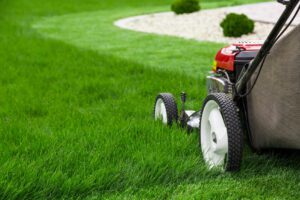 Grass clippings contain a lot of nitrogen and they will break down more quickly than some other mulch options. This means this mulch may need to be applied several times over the growing season. However, it’s best to allow clippings to dry a bit to brown before mulching and only apply 1 to 2 inches of grass clippings at a time. Thick layers of wet grass clippings will mat together and cause drainage issues, but thin layers of clippings can make excellent mulch for vegetable and container gardens. And keep in mind – similar to straw and hay, if you treat your lawn with pesticides and herbicides, those chemicals can transfer to your vegetable garden in the clippings.
Grass clippings contain a lot of nitrogen and they will break down more quickly than some other mulch options. This means this mulch may need to be applied several times over the growing season. However, it’s best to allow clippings to dry a bit to brown before mulching and only apply 1 to 2 inches of grass clippings at a time. Thick layers of wet grass clippings will mat together and cause drainage issues, but thin layers of clippings can make excellent mulch for vegetable and container gardens. And keep in mind – similar to straw and hay, if you treat your lawn with pesticides and herbicides, those chemicals can transfer to your vegetable garden in the clippings.
- Gravel and pebbles shouldn’t be used directly on vegetable garden beds because these materials can get worked into the soil and will make digging difficult and unpleasant. However, if you have walkways running through your vegetable garden, you may want to cover them up with a layer of pea gravel or pebbles. These materials can be aesthetically pleasing in gardens and they can work with a range of garden styles.
-
You Didn’t Use the Correct Soil
Topsoil, also known as blackdirt, is important to having a healthy garden. But topsoil alone falls short of the 3 key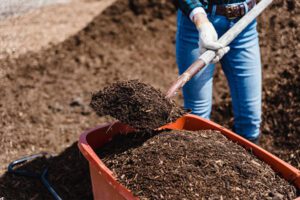 things required for a flourishing garden. Soil should be fluffy, light, and well-draining – a common trait of good sandy loam soil. Gardeners often use garden soil, which can become compacted over time and restrict drainage. Potting soil, by contrast, drains too quickly and usually contains no dirt. They also might go with native soil, which often lacks nutrients and renders it unfit for vegetable growth. To avoid these mistakes, you should buy soil specifically designed for raised garden beds. At Tim Wallace Soil Mix Supply, our Raised Bed and Premium Raised Bed Mixes address all three of the key things needed to insure a great soil for your plants to grow and thrive in:
things required for a flourishing garden. Soil should be fluffy, light, and well-draining – a common trait of good sandy loam soil. Gardeners often use garden soil, which can become compacted over time and restrict drainage. Potting soil, by contrast, drains too quickly and usually contains no dirt. They also might go with native soil, which often lacks nutrients and renders it unfit for vegetable growth. To avoid these mistakes, you should buy soil specifically designed for raised garden beds. At Tim Wallace Soil Mix Supply, our Raised Bed and Premium Raised Bed Mixes address all three of the key things needed to insure a great soil for your plants to grow and thrive in:
1) Primary planting media – plenty of quality topsoil (black dirt).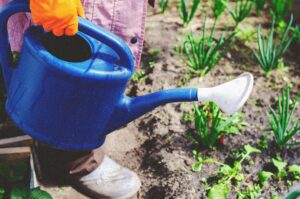
2) Moisture control –organic material for controlling the proper amount of moisture.
3) Organic fertilizer – correct proportions of vigorous organic material such as compost for the results you desire. When included in the right amounts, compost adds vital nutrients to the garden soil mix for good soil health.
Our Raised Bed Mix consists of – 50% topsoil, 25% coarse sand and 25% organic compost.
- The topsoil addresses the primary planting media
- The coarse sand keeps the soil loose, airy and well-drained. Raised beds are notorious for retaining water and becoming too wet which leads to root rot! Sand either retains moisture (fine sand) or controls moisture (coarse sand) for obtaining the optimal moisture control.
- The organic compost is what feeds to soil with vital nutrients for healthy soil and proper plant development. Too much compost can burn tend plant roots. The 25% ratio is perfect the organic fertilizer for garden plants or nearly all kinds.
- The Purple Cow Classic Compost in our Premium Raised Bed Mix brings a top-of-the-line, nationally known and loved compost to your garden bed.
So when it’s time to find out how to start a raised garden bed look no further than Tim Wallace Soil Mix Supply. For more than 40 years we’ve been the leading the industry on soil blend innovation. We mix and prepare your soil blend on-site. Your soil blend is then delivered to your home ready to be put into your planting bed. Just add plants, water and a little love. For the best results – start with the best soil, and look no further than Tim Wallace Soil Mix Supply. Call us today to set up the delivery of your garden soil. (630) 759-1080.


 soil erosion. In-ground gardens with their direct contact of plants with the ground makes them more susceptible to weed growth, pest infestation and soil-borne diseases. Additionally, In-ground beds also require regular soil maintenance, such as tilling and amending, to ensure optimal growing conditions.
soil erosion. In-ground gardens with their direct contact of plants with the ground makes them more susceptible to weed growth, pest infestation and soil-borne diseases. Additionally, In-ground beds also require regular soil maintenance, such as tilling and amending, to ensure optimal growing conditions.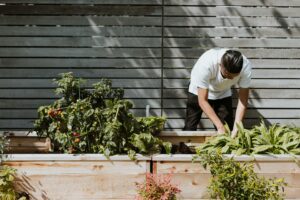 bigger and more healthy and productive plants. But you might be thinking: Doesn’t an in-ground garden bed inherently have “deep” soil too? Yes, but you must consider the composition of the native soil. In and around the southwest suburbs of Chicago here the native soil in largely clay, large rocks, or other less-than-ideal soil structures. As such, you’re either going to need to work really hard to till and amend the soil deeply, or remove a large portion of the native soil and then re-introduce a sandy loam soil mix. (A great sandy loam soil is rich in organic matter, has a texture that is loose enough to easily allow root growth, will readily absorb water, and is also well-draining. We build these positive characteristics into all of our Raised Bed garden blends.)
bigger and more healthy and productive plants. But you might be thinking: Doesn’t an in-ground garden bed inherently have “deep” soil too? Yes, but you must consider the composition of the native soil. In and around the southwest suburbs of Chicago here the native soil in largely clay, large rocks, or other less-than-ideal soil structures. As such, you’re either going to need to work really hard to till and amend the soil deeply, or remove a large portion of the native soil and then re-introduce a sandy loam soil mix. (A great sandy loam soil is rich in organic matter, has a texture that is loose enough to easily allow root growth, will readily absorb water, and is also well-draining. We build these positive characteristics into all of our Raised Bed garden blends.)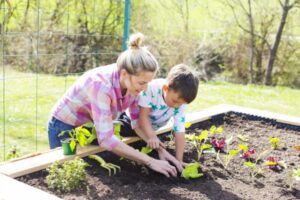 they’re naturally resistant to insects and decay. The drawback with these wood options is that they can be expensive.
they’re naturally resistant to insects and decay. The drawback with these wood options is that they can be expensive.
